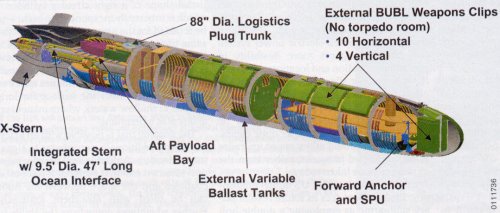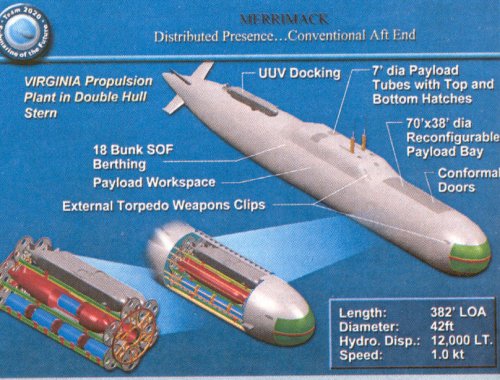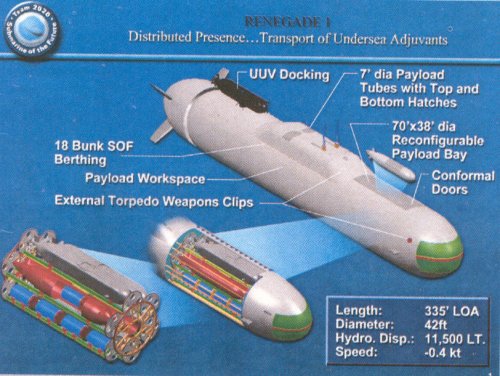COLEMAN RESEARCH CORP
5950 LAKEHURST DR
ORLANDO, FL 32819
Program Manager: JOEL GREENSTEIN
Contract #: N6601-91-C-7005
Tide: A TETHERED FLOATING FIBER OPTIC PERISCOPE FOR SUBMARINES
Topic #: N90-296 Office: NOSC ID #: 43241
A REMOTE PERISCOPE IS PROPOSED THAT CAN BE DEPLOYED FROM A SUBMARINE. THE DEVICE REPLICATES
THE FUNCTIONS OF A CONVENTIONAL PERISCOPE WHILE MAINTAINING ITS UNIQUE FEATURES.
PRELIMINARY REQUIREMENTS ON THE NEW DEVICE HAVE BEEN SET. THE DEVICE SHOULD RISE TO ABOUT
4 m ABOVE THE WATERLINE FOR VIEWING OVER WAVES. THE RANGE SHOULD BE GREATER THAN 10 km.
THE PERFORMANCE AT RANGE SHOULD BE SUFFICIENT TO DETECT AND RECOGNIZE SMALL OBJECTS. THE
PERISCOPE SHOULD HAVE A +60 TO -5 DEG FIELD OF REGARD IN ELEVATION AND 360 DEG IN AZIMUTH.
A MAXIMUM POSSIBLE FIELD-OF-VIEW (FOV) IS DESIRABLE. DIRECT OPTICS FOVs ARE OPTIMISTIC GOALS
FOR IMAGING DEVICES. THE OPTICAL ELEMENT DIAMETER, d, HAS DIRECT BEARING ON THE
PERFORMANCE. THE LARGER d, THE LARGER EFFECTIVE RANGE. HOWEVER, OBSERVABILITY, SIZE, AND
COST OF THE PACKAGE ALSO GROW WITHd. AFTER RELEASE FROM A STORAGE TRUNK, THE DEVICE
(PROPORTIONED LIKE A TORPEDO) SWIMS TO A REMOTE STATION JUST UNDER THE SURFACE, FAR FROM
THE SUBMARINE. HERE, THE AFT PORTION IS FLOODED, CAUSING A ROTATION TO VERTICAL. THE
FORWARD PART IS THEN RAISED IN A MANNER SIMILAR TO THAT OF A CONVENTIONAL PERISCOPE. TWO
STABILIZATION SYSTEMS WILL BE USED. THE FIRST (COARSE) SYSTEM WILL KEEP THE DEVICE VERTICAL
AND WILL HOLD STATION AGAINST SURFACE SURRENTS. THE FINE SYSTEM WILL STABILIZE THE
LINE-OF-SIGHT (LOS) TO A TARGET BY MOVING A MIRROR IN THE PERISCOPE HEAD. THE FINE SYSTEM
WILL MOVE THE MIRROR IN PITCH AND YAW. ROLL ABOUT THE LOS WILL BE STABILIZED
ELECTRONICALLY.
OSBORNE ASSOCIATES INC
756 LAKEFIELD RD - BLDG J
WESTLAKE VILLAGE, CA 91361
Program Manager: ANDREW BAZELEY
Contract #: N66001-91-C-7006
Title: A TEHTERED FLOATING FIBER OPTIC PERISCOPE FOR SUBMARINES
Topic #: N90-296 Office: NOSC ID #: 43247
THE PHASE I PROJECT WILL DEVELOP THE TECHNICAL SPECIFICATION FOR A FIBER OPTIC REMOTE
SURFACE SENSOR PLATFORM SYSTEM (FORSSEPS) THAT CAN BE DEPLOYED FROM A SUBMERGED
SUBMARINE AND WHICH CAN BE REMOTELY DIRECTED TO THE SURFACE OF THE OCEAN TO GATHER
VISUAL AND RF INFORMATION WHILE MINIMIZING RISK EXPOSURE IN A VARIETY OF TACTICAL AND
OPERATIONAL SITUATIONS. THE PREEMINENT DESIGN CRITERIA FOR THE FORSSEPS VEHICLE AND SENSOR
PLATFORM WILL BE THAT IT PROVIDE SUFFICIENT STABILITY THAT EFFECTIVE 360 DEGREE IMAGING CAN
BE ACCOMPLISHED WITH LOW RISK OF DETECTION. IN ADDITION, THE FORSSEPS VEHICLE MAY BE
EQUIPPED WITH VARIOUS RF AND OPTICAL APERTURE SENSORS, THEREBY ENABLING COMMUNICATIONS
LINKS WITH SATELLITES, ELINT, ETC. THROUGH USE OF A FIBER OPTIC LINK AND BY PROVIDING THE
VEHICLE WITH ON-BOARD PROPULSION, STANDOFF RANGES OF SEVERAL KILOMETERS CAN EASILY BE
ACHIEVED FROM THE PARENT SUBMARINE. ALTERNATELY, BE EQUIPPING THE FORSSEPS VEHICLE AS A
HYDRODYNAMIC LIFTING BODY THAT CAN BE TOWED TO THE SURFACE, SURVEILLANCE MISSIONS CAN
BE CONDUCTED WHILE THE PARENT SUBMARINE IS UNDERWAY. THE SPECIFICATION DEVELOPED WILL
ADDRESS THE PROPOSED FORSSEPS VEHICLE DESIGN, THE STABILIZED SENSOR PLATFORM, THE IMAGING
SYSTEM, THE FIBER OPTIC DATA LINK, NAVIGATION SENSORS, THE LAUNCH AND RECOVERY SYSTEM AND
THE OPERATORS CONTROL STATION.
7932 W 79TH ST
PLAYA DEL REY, CA 90293
Program Manager: HARRY NELSON
Contract #: N66001-91-C-7004
Title: A TETHERED FLOATING FIBER OPTIC PERISCOPE FOR SUBMARINES
Topic #: N90-296 Office: NOSC ID #: 43248
THE PURPOSE OF THIS PHASE I STUDY IS TO DETERMINE THE FEASIBILITY OF A REMOTE IMAGING AND
TRACKING PERISCOPE THAT CAN BE FREE FLOATING, BUT TETHERED TO A SUBMARINE. THE FLOATING
PERISCOPE CONTAINS A TWO- AXIS STABILIZED LINE OF SIGHT FOR VARIOUS IMAGING VISIBLE AND
INFRARED CAMERA SYSTEMS THAT PROVIDE VIDEO DATA VIA A FIBER-OPTIC DATA LINK TO A REMOTE
SUBMERGED SUBMARINE. THE PERISCOPE TO BE FEASIBLE AND ECONOMICAL USES VARIOUS DEVICES, I.E.,
IR AND VISIBLE CAMERAS, STABILIZATION SYSTEMS, AND TRACKERS, AND POWER SUPPLIED, THAT ARE
ALREADY IN THE DoD INVENTORY. COMBINING THESE EXISTING DEVICES AND ELECTRONICS ALONG WITH
AN EXISTING FIBER-OPTIC DATA LINK (ARMY FOG-M MISSILE) INTO A UNIQUE PERISCOPE SYSTEM AND
SPECIFYING THE SYSTEMS DESIGN REQUIREMENTS FORMS THE PHASE I REPORT.
SMALL BUSINESS INNOVATION RESEARCH PROGRAM - PHASE I
NAVY Solicitation 90.1



















